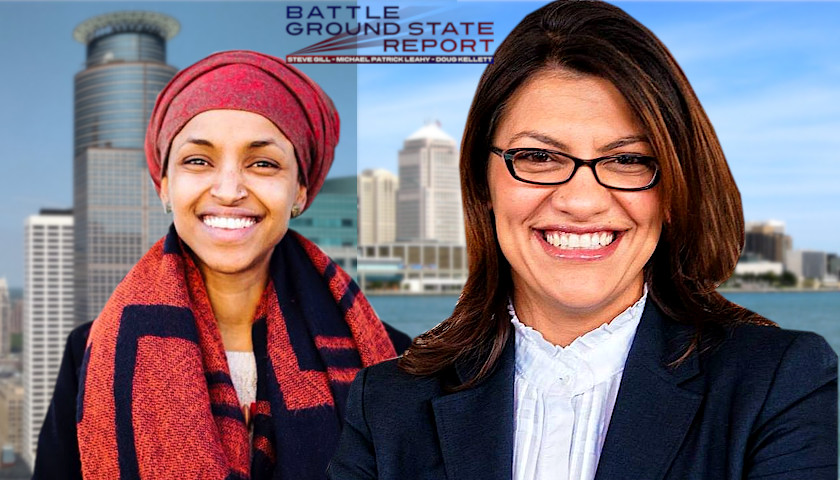On Friday’s Battleground State Report with Steve Gill, Michael Patrick Leahy and Dough Kellett – a one hour radio show from Star News Digital Media in the early stages of a national weekend syndication rollout – the three hosts discussed the radicalization of cities in both Battleground States, Minnesota and Michigan and what that could mean for the 2020 Presidential election.
The hosts agreed towards the end of the segment that Trump has a possibility of turning those states around if he can capture the dueling Muslim and Jewish vote.
Gill: As we continue to point out, it’s not really a national election. It is a compilation of a patchwork quilt of what you do in individual states. and that’s why you’re not going to see a lot of campaigning by President Trump in California other than maybe to raise money. Although I do think, his presence helps in places like Orange County to maybe win some congressional seats back. By the same time, you’re not going to see the Democratic candidates for President spending a lot of time in places like Alabama, or Mississippi or Tennessee. Those states are pretty much firmly in the fold of whatever typical background they follow. There’s really about seventeen states and ultimately, I think, at the end of the day we’re going to see this come down to five or six states where everybody’s going to pour all their resources. We saw that in the last election cycle where if you were in Ohio, every single commercial in every single stock break was a political attack ad either funded by candidates, by the national parties, or by these independent C-3, C-4 organizations. And it’s going to start, it’s going to start early. You’re already starting to see the I don’t know, we may have thirty candidates initially for President on the Democratic side of the aisle, you know, burrowing into places like Iowa and New Hampshire. Where folks there are going to get sick of seeing them.
Leahy: Now, we look at the interesting, two states in our Battleground States have a lot of common, Michigan and Minnesota. Now, what do they have in common? They’re about the same size, Michigan’s a little bigger. There are sixteen electoral college votes. President Trump won Michigan’s electoral college votes by eleven thousand votes. Minnesota, ten electoral college votes. President Trump lost to Hillary Clinton there by about forty thousand. But what they have in common is, they both have very very far left radical groups in their cities and far left radical Muslim contingents that have elected the first two Muslim members of Congress. In Detroit area, Dearborn, Dearbornistan, you have Rashida Taliab, is that how you…
Gill: Taliab.
Leahy: Rashida Taliab and then in…
Gill: She’s the one who dropped the MF bomb on Donald Trump.
Leahy: Yes.
Gill: And danced around with a Palestinian flag on election night rather than an American flag showing where her loyalties lie. That’s the representative of the Dearborn suburb of Detroit that they sent to Congress.
Leahy: And then in Minneapolis, the successor to Keith Ellison, Ilan…
Gill: Omar.
Leahy: Omar, whose claim to fame is she married her brother to violate immigration laws
Gill: She’s a Somali refugee and a large Somali population there.
Gill proceeded to discuss the overwhelming blue and anti-American cities which are reflected by their leadership and although the rest of these states appear have an overwhelmingly amount of red counties across them (i.e. Michigan and Minnesota), can’t generate enough votes to penetrate the population of those blue urban centers. He noted, as an example, by looking at the United States political landscape that there is a vast state of red across the country and that the urban centers again manage to become the weight carriers during an election. Republicans need to find a way to get more of the Hispanic and African American group vote to take some votes out of those Democratic cities. Fifteen to sixteen percent of those votes could get Trump the win, Gill confided.
Leahy: Doug, you know in both Michigan and Minnesota, the urban areas the blue parts of the state are getting bluer. And they’re very aggressive. They’re very anti-Trump. They’re pretty nasty actually. In terms of what…
Kellet: What do you think the, I mean and that’s certainly true. But, what are the issues that appeal let’s say, to Muslim Americans? You know you mentioned Dearborn Michigan and these particular areas. Is there an area for Republicans to garner some of these votes? Or is this, exactly what is making them be, you know, more left? Is there a particular issue here?
Gill: I think part of is that they’re not from America. They’re not culturally in tune with American culture and by that, I don’t mean you know, a race-based issue. I don’t care whether you’re from Chechenia or a White Muslim or from Mexico and are a Hispanic Catholic. If you are not embracing America, American ideals, the rule of law. If you’re coming here for what you can get instead of what you can be a part of, then you’re not fully ingrained in what America is. And I think you’ve got the Democrats certainly, is one of the reasons you’re seeing the big border fight. They are losing American voters. They’ve got to bring in more illegal voters to continue to carry the day. They’ve got to engage in more of the shenanigans we saw in this past election with voter harvesting, and voter fraud, voting dead people. That’s their path to victory. Because when you look, in these, particularly in these rust belt states. The blue-collar, populist voting voters are the ones that carried Donald Trump to victory. As the Democrats lose those…
(Inaudible crosstalk)
Gill: They’ve got to pick up somebody somewhere.
Kellet agreed to the analyzation yet stated that in the past he would receive call in’s to his shows for years talking about African American issues and women’s issues and would respond by asking people what they thought about less government, less taxation, and more freedom. He noted that these immigrant countries are not based in freedom and don’t assimilate. Gill in response talking about the immigrants that come here for ‘something for nothing’ and how socialism appeals to them. Gill went on to discuss how new elected Congresswoman, Rashida Taliab is vocal in her stance as an anti-Israel and anti-Semitic. He questioned the Republicans can’t get the Muslim vote and Jewish vote when they hate each other adding that their vote is rooted in their political identity instead of issue-based views. “How is this not possible”, said Gill.
Leahy and Gill concluded the conversation by comparing and contrasting the group of four women that seem to be bound by an anti-Israeli policy and hate everything that has to do with Israel. Gill described the other members, aside from Tliab and Omar, as being Linda Sarsour, a far left, totalitarian and anti-Semitic, coupled with Alexandra Ocasio-Cortez, a socialist. The men agreed that the refugees that enter America, (Columbus Ohio, Minneapolis, Minnesota, are the largest Muslim populations) do not assimilate, and instead use the term integration (in the wrong way), which in turn really means a rejection of American culture. “Do you think the increasing polarization in Michigan and Minnesota is going to turn those states one way or another?” asked Leahy.
At the end of the segment, the men agreed that they will see more backlash, more fights, and more polarization. “That’s what we have to look forward to,” concluded Leahy.
Listen to the full show:
– – –
Tune in every Friday morning and listen to TheBattleground State Report with Steve Gill, Michael Patrick Leahy, and Doug Kellett.
Photo “Ilhan Omar” by Ilhan Omar.
Photo “Rashida Tlaib” by Rashida Tlaib.





